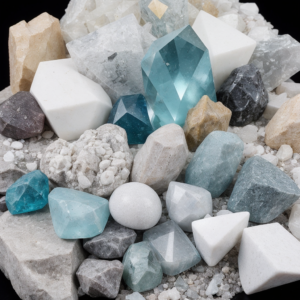The Mohs hardness scale is a method of classifying minerals based on their resistance to scratching. Created by German mineralogist Friedrich Mohs in 1812, this scale remains a standard in geology and mineralogy for measuring the hardness of minerals and other materials. Understanding this scale is essential not only for geologists but also for jewelers and mineral collectors, as it provides an easily comprehensible reference for the durability and resilience of materials.
History and Origin of the Mohs Scale
 The Mohs Scale was developed in 1812 by German geologist and mineralogist Friedrich Mohs. This scientist was fascinated by the physical properties of minerals and sought a systematic way to classify them based on their hardness. In geological terms, hardness refers to a mineral’s resistance to being scratched. Mohs observed that certain minerals could scratch others, leading him to create a comparative scale.
The Mohs Scale was developed in 1812 by German geologist and mineralogist Friedrich Mohs. This scientist was fascinated by the physical properties of minerals and sought a systematic way to classify them based on their hardness. In geological terms, hardness refers to a mineral’s resistance to being scratched. Mohs observed that certain minerals could scratch others, leading him to create a comparative scale.
Friedrich Mohs selected ten common minerals that represented a range of hardness, from the softest to the hardest. These minerals were talc, gypsum, calcite, fluorite, apatite, orthoclase, quartz, topaz, corundum, and diamond. Each mineral on this scale can scratch those below it and be scratched by those above it.
Talc, with a hardness of 1, is the softest mineral on the scale. It is so soft that it can be easily scratched with a human fingernail. At the other end of the scale is the diamond, with a hardness of 10, the hardest known mineral, capable of scratching all other minerals.
The creation of the Mohs Scale was a significant advancement in mineralogy and geology, providing a simple yet effective tool for identifying and comparing mineral hardness. This scale is fundamental not only for geologists but also has practical applications in various industries, including jewelry and tool manufacturing.
Importance and Use of the Mohs Scale
The Mohs Scale remains relevant today due to its simplicity and utility. While more precise methods for measuring mineral hardness exist, the Mohs Scale offers a quick and easy way to identify minerals in the field.
In the jewelry industry, for instance, a mineral’s hardness is crucial for determining its durability and suitability for different types of jewelry. A mineral with high hardness, such as diamond, is ideal for engagement rings and other jewelry subjected to daily wear.
Additionally, in tool and abrasive manufacturing, knowing the hardness of materials is essential. Harder materials like diamond and corundum are used in cutting tools and abrasives because of their ability to scratch and wear down other materials.
The Mohs Scale also plays an important educational role, helping students and geology enthusiasts better understand the physical properties of minerals. Through this scale, it is possible to appreciate how minerals interact with each other and how their physical properties determine their uses and applications.
In summary, the Mohs Scale, developed by Friedrich Mohs in the 19th century, continues to be an invaluable tool in geology and mineralogy, as well as in various industries and practical applications.
How the Mohs Scale Works
The Mohs hardness scale classifies minerals on a scale of 1 to 10, with 1 being the softest and 10 being the hardest. Each mineral can scratch those below it on the scale but not those above it. Here are the original minerals Mohs used, ranked from least to most hard:
| Number | Mineral | Description |
|---|---|---|
| 1 | Talc | The softest mineral; easily scratched by a fingernail. |
| 2 | Gypsum | Can be scratched with a fingernail; used in plaster of Paris. |
| 3 | Calcite | Can be scratched with a copper coin. |
| 4 | Fluorite | Can be scratched with a steel knife. |
| 5 | Apatite | Scratches glass and can be scratched by a steel file. |
| 6 | Orthoclase (Feldspar) | Scratches glass and is scratched by quartz. |
| 7 | Quartz | Scratches glass and steel; found in most sands. |
| 8 | Topaz | Scratches quartz; commonly used in jewelry. |
| 9 | Corundum | Includes sapphires and rubies; scratches topaz. |
| 10 | Diamond | The hardest mineral; scratches all other minerals. |
Practical Applications of the Mohs Scale
The Mohs scale, initially developed to classify minerals by their hardness, has found a wide range of practical applications across different industries. Its simplicity and effectiveness make it an indispensable tool not only in geology but also in jewelry, construction, education, and other areas.
Jewelry
In the jewelry industry, the Mohs scale is crucial for determining the suitability of gemstones for different types of jewelry. Because the hardness of a mineral indicates its resistance to scratches and wear, knowing this attribute is essential for jewelers.
- Diamonds: With a hardness of 10, diamonds are ideal for engagement rings and other daily-wear jewelry due to their extreme scratch resistance.
- Sapphires and Rubies (Corundum): With a hardness of 9, these gemstones are also very durable and frequently used in fine jewelry.
- Quartz: With a hardness of 7, quartz is used in a variety of jewelry but is more susceptible to scratches compared to diamond and corundum.
Construction Industry
In construction, the Mohs scale is used to select materials that will be subjected to wear and abrasion.
- Natural Stone: Materials such as granite and marble, which have different degrees of hardness, are selected based on their specific application in flooring, countertops, and cladding.
- Tools and Equipment: The hardness of minerals is essential for manufacturing cutting and drilling tools. Industrial diamonds, due to their extreme hardness, are used in drill bits and saw blades to cut other hard materials.
Education
The Mohs scale is a fundamental educational tool in teaching geology and mineralogy.
- Geology and Mineralogy: Students use the scale to identify and classify minerals in the lab and field. They learn to compare the hardness of different samples and understand how this property influences the practical use of minerals.
- Materials Science: In scientific education, the Mohs scale is taught as part of a broader study of the physical properties of materials and their impact on engineering and manufacturing.
Other Applications
Besides jewelry, construction, and education, the Mohs scale has other practical uses.
- Abrasives Industry: Abrasives used for sanding, polishing, and cutting are selected based on the hardness of the materials to be worked on. Corundum and silicon carbide are examples of abrasives used because of their high hardness.
- Conservation and Restoration: In heritage conservation and art restoration, the Mohs scale helps select suitable materials for cleaning and restoring surfaces without causing damage.
Limitations of the Mohs Scale
Although the Mohs scale is very useful, it has certain limitations. It is not a linear scale; the difference in hardness between minerals is not uniform. For example, the difference between corundum and diamond (9 and 10 on the scale) is greater than that between talc and gypsum (1 and 2). Moreover, hardness measured by scratching does not necessarily reflect other properties such as toughness or impact resistance.




